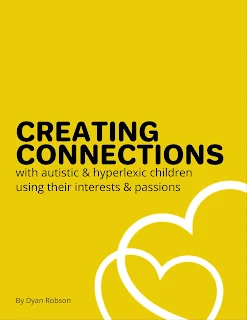One thing you'll hear me say over and over is to use or incorporate your child's interests, whatever they may be.
So, for hyperlexic kids, that's leveraging their interests in letters or numbers or flags or the periodic table...
But maybe you're just not quite sure how to do that exactly or where to start. And that's okay.
Admittedly, some interests are a bit trickier to work with and incorporate, while others are a lot easier.
No worries though. You'll find some tips for using special interests below that should make things a bit easier. So let's dig in!
Important Disclaimers for Using Your Child's Special Interests
There are a couple of common mistakes that can be made when leveraging special interests in autism and hyperlexia. In other words, some people approach it all wrong and inadvertently cause more harm than good.
Since you should avoid making these same mistakes, we're going to discuss them first. That way you know what not to do.
1. Don't change their play or limit it
The goal should never be to change how an autistic or hyperlexic child plays. All forms of autistic and hyperlexic play are valid so it's important that you respect their play, no matter what form that comes in (see strategy #2 here for more information).
So don't correct them or tell them how to play with certain materials. Instead, let them lead.
After all, play should be child-led. Let them guide how they want to interact and engage with the materials.
Also, please don't limit or take away things that are important to them, which - newsflash - their special interests are incredibly important to them. You can read more about why you shouldn't discourage your hyperlexic child's letter play here to get a better understanding of why you shouldn't limit access.
Although, please note, if a special interest is causing harm to themselves, others, or property, then you may need to redirect their play to something safer. That's the only exception here.
2. Do not use their special interests as rewards or for manipulating them into doing something
Want to know the quickest way to suck the joy right out of your child's special interests? Well, every time you withhold access to their interests as a reward or use their special interests to manipulate them into complying, that's exactly what you're doing.
Special interests should be incorporated into other activities, not used as a way to manipulate a person into behaving or acting a certain way. Compliance should never be the main goal for accessing their special interest.
Tips for Using Special Interests in Autism & Hyperlexia
So now that you know what not to do, let's look at what you should do when it comes to leveraging special interests. After all, it's incredibly important that you do encourage their interests, especially considering how many benefits there are to doing so.
1. Use their interests as a calming/coping strategy
For many autistic and hyperlexic individuals, engaging with a special interest has a calming effect. Their interest can be a source of comfort or help distract them when they feel stressed. In other words, engaging with the special interest can reduce anxiety (see benefit #6 here) and build self-regulation skills. That may look like:
- Offering them extra time to organize and alphabetize their letter magnets or to line up cars in rainbow order after a long day at school
- Creating calm down tools that use their interest (such as this traffic light mindfulness activity or this Mario inspired deep breathing exercise)
2. Incorporate their interests into the learning process
This tip is all about teaching to their talent (see point #7 here). You can easily add their favorite things to any learning activity just by simply adding some relevant clipart or using their favorite toys. You just have to get creative! For example, this tip may look like:
- Counting Pokemon figures as a way to practice math facts instead of using math cubes or counting bears
- Making printable writing worksheets with clipart and the names of previous presidents as a way to work on handwriting skills
- Making a craft related to their special interest to work on fine motor skills
3. Incorporate their interests into play, therapy, and school
Before my son was officially identified as autistic and hyperlexic, we did a lot of hands on sensory play. So, over the years, we have done tons of activities that leveraged both of my sons interests. It's kind of my jam. There's a reason why there are so many math, letter, Pokemon, music, and video game related ideas on my blog!
The point here is that interest based activities and materials should be offered at home, in therapy, and at school. That may look like:
- Rolling playdough into letters and numbers as a way to explore new sensory experiences
- Printing off a game of logo or flag bingo as way to work on speech and language
- Building letters out of LEGO as way to encourage them to play with a toy they wouldn't normally want to play with
- Letting them teach about their special interest as part of a presentation at school
4. Use their interests to model and build social skills
Encouraging your child to talk about their special interests can provide you with a great opportunity to model and build social skills such as turn taking, asking follow up questions, staying on topic, being a good listener, etc. You can also build these skills while playing. That may look like:
- Playing with letters, making them go down a slide, for instance, and saying, "It's G's turn to go down the slide!" or "P wants a turn!"
- Asking your child relevant questions about their special interest and giving them time to answer
- Looking for a special interest group so they can meet others who share their interests, build friendships, and make connections
5. Use their interests to boost speech and language skills
Your child's special interests are a great way to build speech, language, comprehension skills, and communication. This may look like:
- Modeling scripts (or gestalts) while playing alongside your child with their special interests
- Encouraging them to talk about or share their passions with you
- Using games based around their special interests to practice speech sounds or articulation
- Practicing comprehension strategies using stories about their preferred interest
6. Incorporate their interests into family life & daily routines
There are lots of ways to incorporate their interests into family life and day-to-day life. Again, you might have to get a bit creative here, but it's worth it! This may look like:
- Serving up number pancakes for breakfast on Saturday mornings while you watch some Numberblocks episodes
- Planning experiences around their interests (e.g., going to a movie, visiting a museum related to their special interest, etc.)
- Playing a board game together as a family that's related to their special interest
- Buying alphabet pajamas and bedsheets to help with bedtime routines
- Doing a family read aloud with a book about their special interest
- Making a visual schedule that includes clipart of their interests
- Writing social stories that use their favorite characters or interests
7. Use their interests to teach intrinsic motivation
We're not talking about rewards or extrinsic motivation here. We already discussed that earlier in the post. Instead, we're talking about developing intrinsic motivation, where they're driven to engage in a task simply because it's enjoyable and fun. That means you are:
- Encouraging them to pursue their interests and let them go all-in (get tips for encouraging special interests here)
- Offering them a choice to do interest-based projects versus forcing them to do a specific topic or project
- Never forcing them to comply in order to earn their special interest
Need More Ideas for Using Your Child's Interests?
If you still need some guidance with this topic, I highly recommend checking out the book Just Give Him the Whale! It has lots of suggestions for using a child's interests.
But I get that sometimes a child's special interests may be a bit more unusual or unique and it might be harder to come up with good ways to naturally incorporate their interests...
Well, The Creating Connections workbook and ebook might be just what you need! It's all about using an autistic or hyperlexic child's interests and passions, no matter how different they are, from lawn mowers to elevators!
Get your copy of the Creating Connections ebook
Hopefully with the tips and suggestions above you feel much more confident using special interests in autism and hyperlexia. Good luck!
















